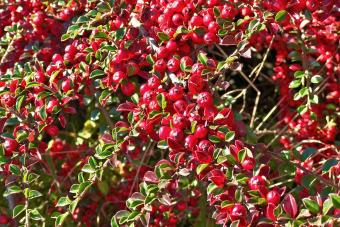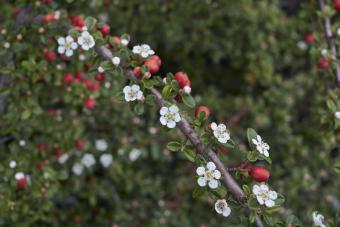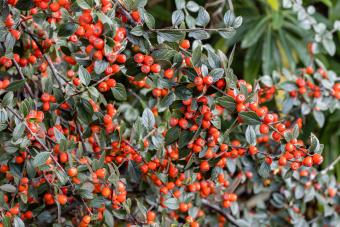
If you're looking for a low-maintenance, drought-resistant plant that provides up to four seasons of interest and is attractive to wildlife, you might want to consider adding a cotoneaster or two to your landscape. Available in both evergreen and deciduous varieties, you can find them in groundcover, shrub, or tree forms.
Cotoneaster: A Beautiful, Hardy Garden Plant

Cotoneasters are low-growing, dense plants that are generally used as groundcovers. There are a few varieties with a more upright growth habit that are grown as shrubs, as well. It's a diverse plant family, and can range from one foot tall up to 20 feet tall, depending on variety.
Cotoneasters are either deciduous or evergreens that usually bloom in spring or summer. They're hardy in Zones 4 through 7 and are tough plants in general, resistant to drought and cold, and generally pest-free as well. If there's a spot in your garden that you've been having a tough time finding the right plant for, consider cotoneaster; it'll look good all year round with very little work on your part.
How to Grow Cotoneaster

Cotoneasters are forgiving plants that don't require much maintenance once they're established in the garden. They need a spot in full sun to partial shade and well-drained soil. They're fairly tolerant to most soil types, but they do not like soggy areas or heavy clay soil. If you have loamy or sandy soil, or even gravelly soil, they'll do well.
For the first year, cotoneaster needs regular watering, but after that you won't have to give it supplemental water unless your area is experiencing an extended drought. They also don't need any additional fertilizing. However, giving the soil around cotoneasters an inch or two topdressing of compost every spring will go a long way toward keeping the plants growing strong.
Pruning Cotoneaster
You don't need to prune cotoneaster unless you think it's getting too large or starting to spread too much. However, it's always a good idea to snip out any dead branches to keep the plant looking its best.
Cotoneaster Pests and Problems
The only serious pest issue you might contend with when growing cotoneasters is cotoneaster webworm, which can decimate the leaves, skeletonizing them and ultimately weakening the plant overall. If you catch the infestation quickly (through regular monitoring), they're not difficult to get rid of:
- Simply pick larvae off of the plants and destroy them.
- Prune out any nests, which look like webs.
- You'll have to check regularly to ensure that you've gotten them all.
If the infestation is already too heavy for handpicking, you might have to use a chemical pesticide to get rid of the cotoneaster webworms.
Cotoneasters are deer-resistant and don't have any serious disease issues.
Cotoneaster Varieties to Grow in Your Garden
Whether you're looking for a low-maintenance shrub or a ground cover that provides color and beauty all season long, a cotoneaster might be just what you need in your garden. In general, they need a spot in full sun to partial shade, but they're not pick about soil, so there's quite a bit of flexibility in how you choose to use this plant in your garden.
Plumed Cotoneaster (Cotoneaster Horizontalis)

Cotoneaster horizontalis has frond-like branches and an almost horizontal growth habit. It has small leaves, growing densely along the thick, sturdy branches. The fall color of this variety is stunning, almost a glowing red color, with the exception of those on the tips of the shoots. The berries are very showy, bright scarlet, and the tiny whitish-pink flowers are very pretty, as well as attractive to bees and other pollinators.
Cranberry Cotoneaster (Cotoneaster Apiculatus)

Cranberry cotoneaster is perfect to use as a groundcover or low hedge. Its spreading branches grow in a herringbone pattern. Delicate pink flowers in spring are followed by large, attractive ruby-colored berries that add winter interest to the garden. This is a deciduous variety.
Creeping Cotoneaster (Cotoneaster Adpressus)

Photo 109141673 © Blossfeldia | Dreamstime.com Dreamstime cotoneaster adpressus
Creeping cotoneaster forms a low, dense, spreading groundcover. Its flowers are white, with tinges of light rose on the edges of the petals. The fruit is a brilliant red, and ripens in August.
Hollyberry Cotoneaster (Cotoneaster Bullatus)

Hollyberry cotoneaster is a shrub that reaches three to four feet in height, with a somewhat drooping habit. In late summer and fall, it forms berries of a dark blood-red color. Another deciduous cotoneaster, this one has almost blistered-looking leaves for added texture and interest. The flowers are white and it has tiny, pea-sized red fruit in fall.
Boxleaf Cotoneaster (Cotoneaster Buxifolia)

Martin Siepmann / imageBROKER / Getty boxleaf cotoneaster
Boxleaf cotoneaster is a free-growing bush that can grow up to six feet tall, forming a rather wide-spreading bush. The branches are covered in deep green, box-like leaves and the crimson berries are pretty in autumn and provide winter interest as well.
Gray Cotoneaster (Cotoneaster Franchetii)

new zealand transition / Moment / Getty Cotoneaster Franchetii
Gray cotoneaster is an erect-growing handsome shrub, four to five feet in height. It flowers in June, with small white blooms marked with red on the outside of the petals. The berries, which are light orange in color, appear in September, and last during a great part of the winter.
Tree Cotoneaster (Cotoneaster Frigidus)

This cotoneaster variety is a low tree reaching 20 feet or more. During mild winters, some of the leaves will be retained throughout the year, while if the weather is very sharp it will become quite bare, other than the showy fruits which are bright crimson. If untouched by birds, the berries retain their beauty a long time, providing winter interest and food for wildlife.
Littleleaf Cotoneaster (Cotoneaster Microphyllus)

Littleleaf cotoneaster is an evergreen clothed with tiny deep green leaves. It produces tiny white flowers in spring and crimson berries in fall. This is a wonderful variety to use as a groundcover at the edge of beds, or even in a garden trough. If you have a rock garden, consider adding this hardy, delicate-looking cotoneaster.
Simon's Cotoneaster (Cotoneaster Simonsii)

Photo 230144572 © Tom Cardrick | Dreamstime.com Dreamstime Cotoneaster Simonsii
Simon's cotoneaster is an erect, woody shrub of medium height, with long slender branches and shoots covered with stiff hair. The white blossoms appear at the beginning of July, followed shortly after by deep. red berries
What to Plant With Cotoneaster
Cotoneasters provide an excellent companion for many showier garden plants, since they make an attractive, low-maintenance backdrop. Consider planting cotoneaster with:
- Viburnum
- Dogwood
- Rose
- Juniper
- Lilac
- Magnolia
- Spirea
Cotoneaster Makes a Hardy Addition to Any Landscape
Cotoneaster is available in so many varieties that there's bound to be one that appeals to you. Consider adding one of these hardy specimens to your own landscape. Not only is it a low-maintenance wonder, but cotoneaster is also a great addition to a wildlife garden.







